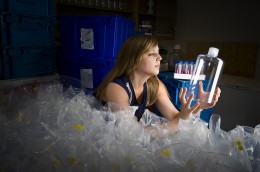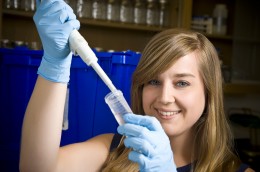The tattoo on top of Katlin Bowman’s left foot reads, “Pray that I won’t live to see the death of everything that’s wild.”
The nature-loving graduate student’s journey at Wright State University has been nothing less than wild.

Bowman works as an undergraduate research technician in a trace metal mercury lab for the Environmental Science Department. That opened the door to her current research—trying to understand how mercury cycles through the ocean.
Bowman has been on five oceanic research cruises, including an Atlantic crossing with several dozen other scientists to examine metal concentrations in the water. She has analyzed samples in a floating lab at all hours and under urgent conditions. And she has collected samples and identified concentrations of mercury in ocean sediments in hopes of reducing the toxin in seafood.
“Wright State has just given me a lot of great research opportunities from the very beginning,” said Bowman, who started doing research as an undergraduate and is currently pursuing her Ph.D. in environmental science. “I was a sophomore in college and just handed this huge opportunity.”
Bowman’s blog during one of the cruises—on the Knorr—paints a picture of work, fun and the power and beauty of nature:
- “Going to sea is like being in grade school and attending your first overnight summer camp. It’s a collection of characters, of people that you normally would never have met but suddenly find yourselves living together, sleeping in bunk beds and relying on each other for moral support.”
- “We spent yesterday on the outskirts of Tropical Storm Sean and encountered some pretty choppy seas. The storm is dwindling down now, but high winds are sustaining swells close to 15 feet and the boat is rolling. Haven’t felt seasick; just realized that it takes twice the amount of energy to analyze samples when you’re getting tossed around the lab!”
- “A couple of Minke whales have been hanging around the Knorr all day today. They’ve been swimming around and underneath the boat and were particularly interested in the particle pumps!”

Bowman has been on five oceanic research cruises, including an Atlantic crossing with several dozen other scientists to examine metal concentrations in the water.
Bowman grew up in the tiny northeast Ohio town of Columbiana, where she was involved in science fair projects for eight years.
“Most of them were environmental, looking at water quality in creeks in the area, tap water, groundwater, well water,” she said. “I think that’s where I started to figure out exactly what I wanted to do.”
Wright State was among her top choices of universities. A full tuition scholarship clinched it.
“I was looking at the best environmental science programs, and Wright State is one of them in Ohio,” she said.
To pay the rent, Bowman got a job at the campus photo copy shop. But then she got a better offer—to work as an undergraduate research technician in a trace metal mercury lab for the Department of Earth & Environmental Sciences. That opened the door to her current research.
Bowman is trying to understand how mercury cycles through the ocean.
Most of the mercury in the environment is from human sources—half of it from the burning of coal. Once mercury falls into the ocean with rain, bacteria can transform it into methylmercury, the form that can accumulate in fish. Nearly all of mercury in humans comes from the consumption of marine fish.
The nervous system is very sensitive to all forms of mercury, especially methylmercury. Exposure to high levels can permanently damage the brain, kidneys and developing fetus. Effects on brain functioning may result in tremors, changes in vision or hearing and memory problems.
It has been estimated that about 6 percent of women in the United States of childbearing age have blood methylmercury levels that are potentially harmful to their unborn children.
Stronger scientific evidence of man-made mercury entering the ocean could influence policy makers to enforce more stringent pollution control regulations and/or put warning labels on seafood.
Bowman analyzes all of her samples while at sea because she needs large volumes of seawater and because the chemistry and mercury change quickly.
“I have a clean laboratory on the ship,” she said. “It’s a very vigorous schedule. As soon as you’re done with one station, you go on to the next. You may get to your station at 10 p.m. or 2 a.m. or 5 a.m. You may be up for 12 or 24 hours trying to get all of your samples done.”
What she has learned, Bowman said, is that the same processes that create high concentrations of the toxic form of mercury in ocean sediments where there is little or no oxygen are potentially affecting the water as well.
Bowman walks off the ships with stacks of data—numbers that she crunches back at Wright State.
“It takes a lot of processing,” she said. “It’s a lot of data entry, a lot of Excel spreadsheets, measuring peaks, calibrating things, double- and triple-checking everything.”
After graduation, Bowman is hoping for a career in research. And the ocean may be in her future, given this blog entry:
- “I’ve been trying to savor every bit of being at sea that I can, sitting outside enjoying the sun during the day and stars at night. I went out to the bow last night, which is often the quietest and darkest place, and saw six shooting stars within 30 minutes.”
Katlin’s blog: Hginthesea.wordpress.com

 Wright State alum Lindsay Aitchison fulfills childhood space-agency dream
Wright State alum Lindsay Aitchison fulfills childhood space-agency dream  Wright State business professor, alumnus honored by regional technology organizations
Wright State business professor, alumnus honored by regional technology organizations  Wright State University Foundation awards 11 Students First Fund projects
Wright State University Foundation awards 11 Students First Fund projects  Gov. DeWine reappoints Board Treasurer Beth Ferris and names student Ella Vaught to Wright State Board of Trustees
Gov. DeWine reappoints Board Treasurer Beth Ferris and names student Ella Vaught to Wright State Board of Trustees  Joe Gruenberg’s 40-Year support for Wright State celebrated with Honorary Alumnus Award
Joe Gruenberg’s 40-Year support for Wright State celebrated with Honorary Alumnus Award 